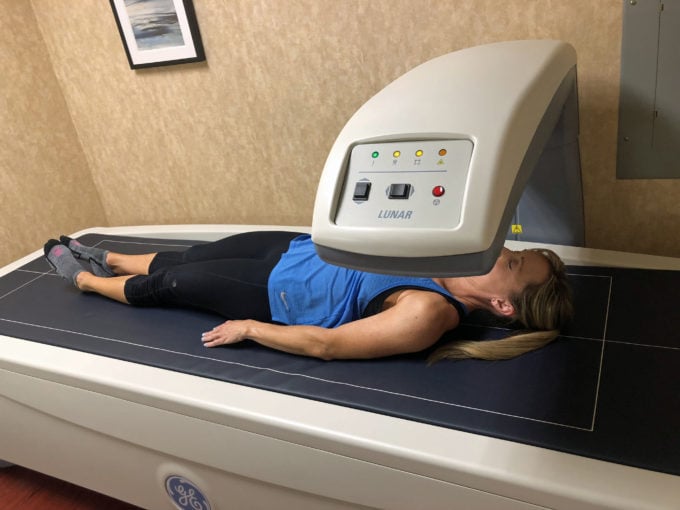DEXA Scan For Bone Density and Body Fat Testing
Have you ever wondered how body composition testing works? What type of information do you receive and how can you apply it to reach your health and fitness goals? I’m here to share my thoughts and experience on two different types of body composition testing, including the DEXA Scan for body fat testing and measuring bone density. This post is sponsored by DEXA SCAN. All opinions are my own.

Recently, I had a DEXA Scan at Better Life Carolinas in Charlotte, NC. I’ve been curious about this type of body composition testing that also measures your bone mineral density. Body composition is a much more useful metric of overall wellness than scale weight or BMI.
I wanted to see how the body composition portion compared to my previous hydrostatic body fat tests in 2015 and 2016. Also, knowing my bone density is important, since my mom has battled with problems associated with osteoporosis.
What Is Hydrostatic Body Fat Testing?
Hydrostatic body fat testing, aka “the dunk tank”, is a method that uses the Archimedes Principal of displacement. You begin by getting your dry weight. Then you’re submerged underwater and weighed to calculate your weight underwater while holding your breath. This process is repeated three times, then an average is taken to calculate your body fat and lean mass percentage. Since lean mass (muscle and bone) is denser than fat and water, a person with a higher body fat percentage will be more buoyant underwater. The technician compares dry weight, underwater weight and the density of the water to come up with your body composition numbers.
The hydrostatic body fat test was referred to as the gold standard in body composition, so it seemed like a good option for my first test back in 2015. It was an easy process. I used a company called BodyFatTest and they brought their mobile testing center to our gym and you’re in and out in less than 30 minutes.
You wear a bathing suit, step on the scale dry to get the initial weight. Then you’re asked to take a deep breath then blow out all your air and submerge three times. I’d say that the biggest con for this test is that you have to get wet. Also, there can be a margin of error if all of the air isn’t released from the lungs when you submerge. The benefit of hydrostatic testing is that it’s fairly reasonable, usually costing between $45-$60.
My Results
The period of time between my first body fat test and my second, I was pretty strictly monitoring my calorie and macronutrient intake. I had 5.8 lbs in total weight lost, with only 1.6 lbs lost in lean (muscle) mass and 4.2 lbs in fat loss. I was rocking a great set of abs, finally! However, in March 2016 is when I had my first of three surgeries for breast cancer.
From the spring of 2016 to now, I’ve had multiple setbacks of injuries and rehab. In my mind, I thought that I should be progressing faster to get back to where I was before. However, my body was clearly not on board. Frustrating would be a huge understatement.
I was forced to spend long periods of time building up stability and working through fascial restrictions, altered muscle recruitment patterns and scar tissue from my surgeries. First starting in my shoulders, followed by a wicked case of ulnar neuropathy and tendonitis. Last summer I re-injured my left ankle resulting in a soft tissue injury and relentless plantar fascitis in the opposite foot. Not fun, y’all, not fun at all.
Getting Back On Track
I have only sporadically tracked my food intake over the last 2 years, focusing primarily on intuitive eating. If I’m feeling a little squishy, then I dial things in, but I definitely haven’t been obsessive about monitoring my food. I have had bigger issues to focus on, like healing my body both mentally and physically. Micromanaging my diet wasn’t part of that process.
I’m currently working with my coach to build more muscle mass. I wanted to see where I stand on overall body composition, so I can create new goals for the coming year. It would be great to get back on the platform and compete in 2019. I was anxious to try out the DEXA and see where my numbers are for formulating my nutrition and strength goals.
DEXA Scan for Body Fat Testing and Bone Health

Pros
- Fast, easy and convenient (it’s nice to stay dry and just lay on a table)
- claims to be more accurate than hydrostatic (however, the DEXA numbers seem to run higher than the hydrostatic results by comparison from what I’ve researched)
- you find out your bone density T-score (thankfully, mine was really good. Lift the weights y’all!!)
- your fat mass is broken down into percentage of Android, Gynoid and Visceral fat
- your lean and fat mass is listed separately for each region of the body (arms, legs, trunk, Android, Gynoid)
Cons
- Accessibility (not all towns have wellness clinics with this technology, but it’s expanding)
- Cost (it’s not cheap at around $100-150 a scan, but worth it if you may be at risk for osteopenia or osteoporosis, metabolic diseases or want to track results specific to your athletic endeavors)
How Does DEXA work?
DEXA stands for dual-energy x-ray absorptiometry, using x-ray technology to determine the distribution of bone, water, lean muscle and fat in the body. It passes two very low-dose x-ray beams at differing energy levels through the tissues of the body. If you’re concerned about the safety of this procedure, you’ll get more radiation riding on an airplane than you will during a DEXA Scan.

The entire process only takes 7 minutes and all you have to do is lay on a table, fully clothed. Definitely a bonus. No swimsuit needed. You get your results immediately and the healthcare professional reviews your results in detail.
For the body fat portion, the fat is broken down by areas of the body and the type of adipose tissue. Visceral fat (the deep abdominal fat) is the big one to keep in check. It’s associated with several types of metabolic diseases and type 2 diabetes. A healthy VAT volume is 0.00-52.0 and mine came out to be .09, so I was definitely happy with that result.
You also get the mass in pounds and percentage of Android fat (abdominal subcutaneous fat) and Gynoid fat (around the hips and thighs), as well as your fat mass on other regions of the body (arms, legs, head, ribs, spine, and pelvis).
I’m looking forward to going back in the spring for my follow-up scan. If you have any questions about the procedure, don’t hesitate to reach out to me. You can also check here if you’d like more information and to search for a DEXA Scan location near you.
- Easy Eggnog Cupcakes with Spiced Rum Whipped Cream Frosting (Alcohol-Free Recipe) - December 15, 2025
- Southern Healthy Fried Chicken - November 10, 2025
- Ground Beef Breakfast Casserole - November 5, 2025


bone density decrease with age…old age people are diagnosed with osteoporosis and osteopenia because of bone density decrease…great post…!!